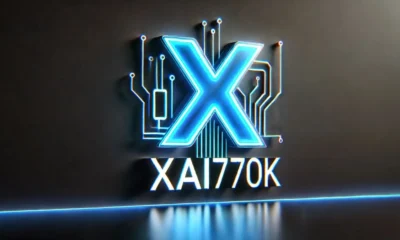TECHNOLOGY
Anon Vault: Preserving Privacy in the Digital Age

Anon Vault is mostly a term used when describing an online storage service, which is mainly aimed at protecting user data and ensuring the user’s privacy. These platforms are actually virtual data storage, personal data storage, and digital currency storage where the user identity is not disclosed. Thanks to the utilization of integrated technologies like encryption or decentralized systems, Anon Vaults guarantees that no one will be able to access the information stored there. People can be relieved by having their data safe, as well as being protected from others spying on them as they browse the internet.
How does Anon Vault work?
The basic working mechanisms that hold most of Anon Vaults’ functions are involved with the user’s anonymity and data safety. Most of which use the technique of end-to-end encryption, thus only the user can open the stored information. The intended data is still in an encrypted form before being transmitted and stays in such form until it gets to the identified receiver or storage area. Also, most of these platforms distribute the data on numerous nodes, which can complicate the work of any of the participants in the network. Not only that, it increases security as well as decreases dependency on centralized servers, therefore making the system less susceptible to Trojan attacks and other related security breaches.

Key Features of Anon Vault Platforms
These platforms come equipped with several key features designed to enhance user privacy and data security. Some of the most notable features include:
- End-to-End Encryption: Ensures that only authorized users can access their data.
- Decentralized Architecture: Distributes data across a network, preventing centralized control.
- Blockchain Integration: Provides immutable records of transactions and access logs.
- Multi-Factor Authentication: Adds an additional layer of security through various verification methods.
These features collectively create a robust environment for secure data storage and management, making Anon Vaults an attractive option for privacy-conscious users.
The Importance of Anonymity in Digital Storage
The issues with anonymity when it comes to digital storage are very important in several ways. People want to shield themselves from possession of confidential records, identity theft, and spying. As cyber threats are growing and government surveillance becomes more common, users appreciate their anonymity and the opportunity to perform actions without being traced. These platforms provide the possibility to store personal data anonymously, so it becomes a perfect solution. This is especially vital for graphic reporters, campaigners, or anyone who reports sensitive information because they expose themselves to harsh consequences. In this manner, these people can be in a position to further their communication and data in such a manner that it is concealed, hence enabling them to enable free flow of expression and, at the same time, assure privacy.
Top Uses of Anon Vaults
These platforms serve various user groups, each benefiting uniquely from their privacy-focused features. The primary users include:
- Cryptocurrency Holders: Anon Vaults offer secure storage for digital assets, protecting them from theft.
- Journalists and Activists: Individuals who require confidentiality to share sensitive information safely.
- Everyday Users: Individuals seeking a secure means to store personal documents, photos, and sensitive information without fear of data breaches.
These diverse applications highlight the versatility of Anon Vaults and their essential role in the modern digital landscape, where privacy is paramount.
Blockchain Integration in Anon Vaults
Applied in Anon Vaults, blockchain technology has a vital function in terms of the security and transparency of the process. Blockchain brings the functionality of creating a ledger of the transactions done within the vault that cannot be changed again. Writing about this aspect might be very valuable for users who keep their funds in cryptocurrencies since it ensures that such assets are protected during trading. Additionally, smart contracts can be built into Anon Vaults to provide autonomous working that increases security and access. For instance, smart contracts can determine who needs to have some sort of access to certain files and under what circumstances, which makes a multiple security layer over sensitive data storage.
Security Features in Anon Vaults
To ensure user data remains secure, Anon Vaults incorporates several security features that provide users with confidence in their data’s safety. These include:
- Access Control Measures: Users can set permissions to determine who can view or edit stored data.
- Multi-Factor Authentication: This adds an extra layer of security, requiring multiple forms of verification.
- Self-Destruct Options: Sensitive files can be set to delete after a specific time or under certain conditions automatically.
- Regular Security Audits: Many platforms conduct frequent audits to identify and rectify potential vulnerabilities.
These features collectively create a secure environment for users, ensuring that their data remains protected against unauthorized access and potential threats.

Potential Risks and Challenges of Using Anon Vaults
Despite their advantages, using Anon Vaults is not without risks. One major concern is the possibility of data loss, particularly if a user forgets their encryption keys or fails to back up their information. Additionally, while these platforms offer enhanced security, they are not immune to hacking attempts, making it essential for users to practice good security hygiene. Legal implications also arise, as the anonymity provided by these platforms can attract scrutiny from authorities in certain jurisdictions. Users must remain aware of digital storage laws and ensure that their use of Anon Vaults complies with local regulations.
How to Set Up and Use an Anon Vault Safely
Setting up and using an Anon Vault requires careful attention to security practices. First, users should choose a reputable platform and download any necessary applications. During setup, it’s crucial to create strong, unique passwords and enable multi-factor authentication for added protection. When uploading files, ensure they are encrypted beforehand, and avoid storing identifiable information that could compromise anonymity. Regularly review access permissions and monitor for any unusual activity. Lastly, backups of encryption keys and sensitive data should be maintained in a secure location to prevent loss. By following these steps, users can effectively utilize Anon Vaults while maximizing their data security.
The Future of Anon Vault Technology
However, with the increasing popularity of privacy concerns abruptly escalating, it looks like that the future of Anon Vault technology is bright. Reflections in encryption and security protocols are likely to improve and, by so doing, offer users increased security for their data and information. Further, decentralization and blockchain system integration is expected to rise, especially given the common desire to avoid dependency on the services of Goss. AI may also be applied to upgrade Anon Vaults’ features to be secure automatically and to include analytical tools for tracking user’s activity. That is the landscape where Anon Vaults are going to be more necessary in the fight for privacy while using the internet.
Conclusion,
This work shows that Anon Vault is a solution to enable the user to be Anonymous and secure their privacy while on the internet. Such uses of advanced encryption and decentralized technologies really provide storage of personal information or valuable assets with an added guarantee that one has control of the same without necessarily having to reveal one’s identity. With privacy being at the forefront ever before, Anon Vaults solves the problem by offering trusted platforms for safe storage or various engaging in transactions.
-

 BIOGRAPHY7 months ago
BIOGRAPHY7 months agoBehind the Scenes with Sandra Orlow: An Exclusive Interview
-

 HOME1 year ago
HOME1 year agoDiscovering Insights: A Deep Dive into the //vital-mag.net blog
-

 HOME1 year ago
HOME1 year agoSifangds in Action: Real-Life Applications and Success Stories
-

 BIOGRAPHY1 year ago
BIOGRAPHY1 year agoThe Woman Behind the Comedian: Meet Andrew Santino Wife




























